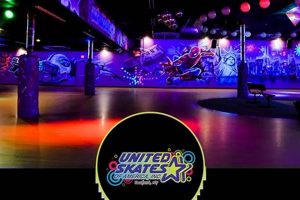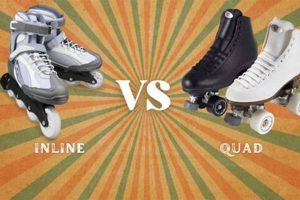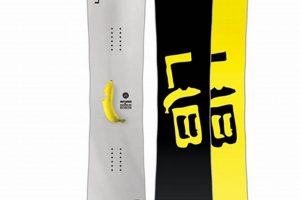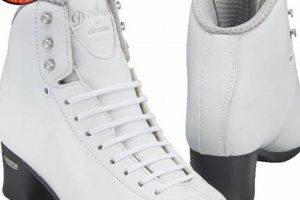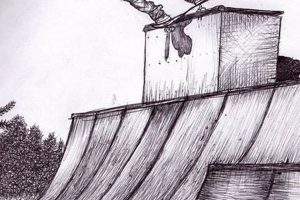The components that connect the various elements of a skateboard, allowing it to function properly, are essential for its operation. These include items such as trucks, wheels, bearings, bolts, and grip tape. For example, trucks attach the wheels to the deck, while bearings enable the wheels to spin smoothly.
Proper selection and maintenance of these elements are critical for both performance and safety. Higher-quality components often result in improved control, stability, and durability. Historically, advancements in materials and design have significantly enhanced the overall riding experience, allowing for more complex maneuvers and greater longevity of the skateboard.
Subsequent sections will delve into the specific characteristics of each of these crucial parts, exploring their function, materials, and available options to ensure optimal setup and continued use. Detailed information will be provided regarding selection criteria, maintenance tips, and troubleshooting common issues.
Optimizing Skateboard Performance
The following guidelines offer practical advice on selecting, maintaining, and utilizing skateboard components to maximize performance and longevity.
Tip 1: Prioritize Truck Selection: The choice of trucks significantly impacts stability and turning ability. Consider axle width relative to deck size for optimal control. Investing in durable, well-constructed trucks is a long-term benefit.
Tip 2: Bearing Maintenance is Crucial: Regular cleaning and lubrication of bearings minimize friction, increasing wheel speed and roll distance. Use a solvent-based cleaner followed by a light lubricant specifically designed for skateboard bearings.
Tip 3: Bolt Tightness Matters: Ensure all bolts are tightened appropriately. Overtightening can damage the deck or trucks; undertightening can lead to instability. Regularly check and adjust bolt tightness before each session.
Tip 4: Wheel Durometer Affects Ride: Wheel durometer (hardness) influences grip and smoothness. Softer wheels (lower durometer) offer greater grip and a smoother ride on rough surfaces, while harder wheels (higher durometer) provide more speed and slide capability.
Tip 5: Grip Tape Should be Replaced: Worn grip tape reduces foot traction, compromising board control. Replace grip tape when it becomes smooth or loses its abrasive quality. A fresh application enhances responsiveness.
Tip 6: Regularly Inspect all components: Regularly inspect all components for wear and tear. Address issues promptly to prevent more significant damage and maintain safe operation. Replace damaged elements immediately.
Tip 7: Consider Riser Pads: Riser pads, placed between the trucks and deck, reduce wheel bite and provide additional clearance. Evaluate the need for riser pads based on wheel size and truck geometry.
Proper care and informed selection of all elements will provide a more enjoyable and safer skateboarding experience. Consistent maintenance ensures peak performance.
The following sections will provide a conclusion to the overall document.
1. Truck Axle Width
Truck axle width is a critical dimension within the context of skateboard components, directly influencing board stability, turning responsiveness, and overall rider control. The selection of an appropriate axle width is paramount for optimizing performance and ensuring a balanced setup.
- Deck Width Compatibility
Axle width should correspond closely with the skateboard deck width. An axle that is too narrow results in reduced stability, while an axle that is excessively wide can impede turning agility. Ideally, the axle should be within a quarter-inch of the deck’s width on either side. A deck of 8.0 inches benefits from a truck axle width between 7.75 and 8.25 inches, maximizing responsiveness without sacrificing stability.
- Turning Leverage and Board Feel
Axle width affects the leverage exerted during turns. Wider axles provide more leverage, increasing stability at higher speeds but potentially reducing the board’s responsiveness to subtle movements. Conversely, narrower axles offer quicker, tighter turns, suitable for technical maneuvers. Skaters prioritizing stability in transition riding often opt for slightly wider axles, while those focused on street skating and intricate tricks may favor narrower setups.
- Wheel Clearance Considerations
Axle width impacts wheel clearance relative to the deck. Inadequate clearance can cause wheel bite, where the wheel rubs against the deck during turns, leading to abrupt stops. Wider axles provide greater clearance, particularly when using larger wheels. Skateboarders using wheels larger than 55mm should consider this aspect of truck axle width to prevent wheel bite and maintain smooth riding.
- Truck Brand Variations
Axle width is not standardized across different truck manufacturers. A truck labeled as having an 8.0-inch axle width from one brand may differ slightly from another. It is crucial to consult the manufacturer’s specifications and, when possible, physically measure the axle to ensure accurate matching with the skateboard deck. Inconsistencies in axle width can affect overall board feel and stability.
The interplay between axle width, deck width, wheel size, and individual riding style is fundamental to optimizing skateboard performance. Careful consideration of these factors contributes to a balanced and responsive setup, enhancing both control and enjoyment. The selection of truck axle width represents a critical aspect of the larger field of skateboard components.
2. Bearing ABEC Rating
The ABEC (Annular Bearing Engineers’ Committee) rating is a system for classifying the manufacturing tolerances of bearings. Within the context of skate hardware, ABEC ratings, ranging from 1 to 9 in odd numbers, are frequently cited as an indicator of bearing precision. While often associated with speed and performance, the direct correlation between ABEC rating and skating proficiency is nuanced. A higher ABEC rating signifies tighter tolerances in the bearing’s construction, potentially resulting in smoother and faster rotation under ideal conditions. However, skate hardware encounters substantial stresses and contaminants not accounted for in the ABEC rating system. For instance, an ABEC 7 bearing subjected to dirt and impact may perform worse than a well-maintained ABEC 3 bearing.
The significance of the ABEC rating within skate hardware is therefore best understood in conjunction with other factors, such as bearing material, lubrication, and maintenance practices. Bearings manufactured from high-quality steel, coupled with appropriate lubrication, exhibit superior performance and longevity regardless of their ABEC rating. Furthermore, regular cleaning and relubrication of bearings mitigate the effects of contaminants, maintaining optimal functionality. Skateboarders often find that diligent maintenance of lower-rated bearings yields comparable or superior results to neglecting higher-rated bearings. In practical applications, the stresses involved in street skateboarding or ramp riding may quickly negate the theoretical advantages of a high ABEC rating if other factors are not carefully considered.
In summary, the ABEC rating is a relevant, but not definitive, characteristic of skate hardware bearings. While a higher rating implies tighter manufacturing tolerances, factors such as material quality, lubrication, maintenance, and riding conditions significantly influence real-world performance. A comprehensive understanding of these interconnected variables enables informed decision-making when selecting and maintaining skate hardware for optimal results. The pursuit of maximum performance should emphasize holistic bearing care rather than sole reliance on the ABEC rating.
3. Wheel Durometer Scale
The wheel durometer scale is a critical specification within the realm of skate hardware, dictating a wheel’s hardness and, consequently, its performance characteristics. It directly impacts grip, speed, and suitability for various terrains and skating styles. Understanding this scale is essential for selecting wheels that complement a rider’s preferences and intended use.
- Shore A Scale and its Range
The Shore A scale is the most common durometer scale used for skateboard wheels. It ranges from 0A to 101A, with lower numbers indicating softer wheels and higher numbers signifying harder wheels. For instance, wheels rated 78A are significantly softer than those rated 99A. This difference in hardness translates directly to grip and shock absorption; softer wheels offer greater grip on rough surfaces and absorb more vibrations, whereas harder wheels prioritize speed and slide capabilities.
- Soft Wheels (78A-87A): Grip and Terrain
Softer wheels, typically ranging from 78A to 87A, are ideal for cruising, longboarding, and navigating rough or uneven surfaces. Their enhanced grip allows for smoother rides and greater control, particularly when dealing with cracks, pebbles, or other obstacles. They also provide better shock absorption, reducing fatigue and enhancing comfort during extended periods of riding. Their use is advantageous in scenarios where maintaining traction is paramount, such as downhill skateboarding or filming.
- Medium Wheels (88A-95A): Versatility
Wheels in the 88A to 95A range represent a balance between grip and speed, making them versatile options for various skating styles. They provide adequate grip for street skating while still offering sufficient speed for park riding and basic tricks. These wheels are suitable for skaters who engage in a mix of activities and require a compromise between traction and rollability. They offer a middle ground, allowing skaters to adapt to different environments without requiring frequent wheel changes.
- Hard Wheels (96A-101A+): Speed and Slides
Hard wheels, ranging from 96A to 101A and beyond, are favored by street skaters and those prioritizing speed and slide capabilities. Their minimal grip allows for controlled slides and easier execution of technical tricks. These wheels excel on smooth surfaces and are commonly used in skateparks and for performing grinds and slides on ledges and rails. Their durability is also advantageous, as they resist wear and tear from abrasive surfaces.
The selection of an appropriate wheel durometer fundamentally influences the overall skating experience. Each wheel hardness caters to a specific set of preferences, and understanding these differences enables skaters to optimize their performance and enjoyment. This choice constitutes a central component when evaluating skate hardware setups.
4. Mounting Bolt Material
Mounting bolt material directly influences the structural integrity of skate hardware, specifically impacting the connection between the skateboard deck and trucks. The material composition dictates the bolt’s tensile strength, shear strength, and resistance to corrosion, factors critical to maintaining a secure and reliable interface during skateboarding activities. Inadequate material selection can lead to bolt failure, resulting in instability and potential accidents. For example, using low-grade steel bolts is a common cause of breakage under the stresses of aggressive riding, highlighting the crucial role of material strength. The selection process also must consider the bolt’s ability to withstand repetitive impacts and vibrations, ensuring long-term reliability of the skate hardware assembly.
Commonly used materials for skate hardware mounting bolts include carbon steel, stainless steel, and various alloys. Carbon steel offers a balance of strength and affordability, suitable for general-purpose skateboarding. Stainless steel provides enhanced corrosion resistance, making it ideal for use in wet or humid environments where rust could compromise the bolt’s integrity. Alloy bolts, often incorporating elements such as chromium or molybdenum, offer superior strength and durability for demanding applications like aggressive street skating or vert ramp riding. The choice of material should align with the rider’s intended usage and environmental conditions to optimize performance and longevity of the skate hardware. The use of incorrect bolt length can also affect the reliability of the assembly.
The appropriate selection of mounting bolt material constitutes a critical, albeit often overlooked, aspect of skate hardware. Prioritizing high-quality materials and correct dimensions is essential for ensuring a safe and reliable connection between the deck and trucks. Failure to do so can lead to bolt failure, compromising stability and increasing the risk of injury. Therefore, awareness of the material properties and their impact on overall performance is indispensable for skateboarders seeking to maximize the safety and lifespan of their equipment. Regular inspection of bolts is also a good maintenance practice.
5. Grip Tape Grit Level
Grip tape grit level represents a critical, yet often understated, aspect of skateboard hardware. It directly influences a rider’s ability to maintain control and execute maneuvers, impacting safety and performance across various skateboarding disciplines. The selection of an appropriate grit level is integral to establishing a secure connection between the rider’s feet and the board surface.
- Grit Particle Size and Composition
Grit tape consists of an adhesive backing coated with abrasive particles, commonly silicon carbide or aluminum oxide. The size and density of these particles determine the tape’s grit level, typically measured in terms of particle size, which affects the coefficient of friction. Finer grit provides less aggressive grip, while coarser grit offers a more secure hold. Composition determines durability, with silicon carbide generally considered more resistant to wear.
- Impact on Foot Adhesion and Board Control
The grit level directly correlates with foot adhesion. Higher grit levels offer enhanced grip, facilitating precise board control during complex tricks and high-speed maneuvers. Conversely, lower grit levels allow for easier foot repositioning and sliding, often preferred by riders who prioritize board feel and footwork. Incorrect selection can lead to slippage, compromising stability and potentially causing injury. The grit level also affects ease of manual tricks, requiring more effort with high grip.
- Influence on Shoe Wear and Durability
Grit tape abrasiveness inevitably affects shoe wear. Higher grit levels accelerate the degradation of shoe soles, particularly in areas of frequent contact. Riders often balance the need for optimal grip with the desire to prolong the lifespan of their footwear. Some opt for protective measures, such as applying shoe glue or using specialized skate shoes with reinforced ollie patches. The higher the grip the faster the shoes wear.
- Adaptation to Riding Style and Conditions
The optimal grit level often depends on riding style and environmental conditions. Street skaters performing technical tricks typically prefer medium to high grit for maximum board control. Park skaters, especially those focusing on transitions, may opt for slightly lower grit to facilitate smoother slides. Wet conditions necessitate higher grit to compensate for reduced friction. Grip levels may require evaluation to fit the skater’s style.
The choice of grip tape grit level represents a fundamental aspect of skate hardware customization. By carefully considering the trade-offs between grip, board feel, shoe wear, and riding style, skateboarders can optimize their setup for enhanced performance and a more controlled riding experience. This seemingly minor detail plays a significant role in the overall functionality of the skateboard.
6. Riser Pad Thickness
Riser pad thickness, measured in millimeters, is a critical specification within the skate hardware domain, directly affecting a skateboard’s ride height, wheel clearance, and overall handling characteristics. These pads, typically constructed from durable plastic or rubber, are installed between the skateboard deck and the trucks. The primary function of riser pads is to elevate the deck, thereby increasing the distance between the wheels and the underside of the board. This modification mitigates wheel bite, a condition where the wheels rub against the deck during turns, causing abrupt stops and potential instability. For instance, skaters using larger diameter wheels (e.g., 56mm or greater) on a deck with standard truck mounting often require thicker riser pads to prevent wheel bite. Without adequate riser pad thickness, such a setup would be unrideable due to the constant friction between the wheels and the deck.
Selecting the appropriate riser pad thickness depends on several factors, including wheel size, truck height, and deck geometry. Higher trucks generally require thinner riser pads, or none at all, as they already provide increased wheel clearance. Conversely, lower trucks necessitate thicker pads to compensate for their reduced height. Furthermore, the deck’s concave and wheel well design can influence the need for riser pads; decks with deep concave or minimal wheel wells are more prone to wheel bite and therefore benefit from increased riser pad thickness. A practical example is a skateboarder transitioning from smaller (52mm) to larger (58mm) wheels. This skater would likely need to add riser pads to maintain a smooth riding experience and prevent wheel bite. Failure to adjust riser pad thickness when changing wheel sizes is a common mistake among novice skaters, leading to impaired performance and potential safety hazards. Improperly sized or installed pads can also compromise the truck’s intended geometry affecting the balance of control.
In summary, riser pad thickness plays a crucial role in optimizing a skateboard’s setup for performance and safety. It is an integral component of skate hardware, influencing wheel clearance, ride height, and overall handling. A thorough understanding of the factors governing riser pad selection, including wheel size, truck height, and deck geometry, is essential for skateboarders seeking to maximize their riding experience. The improper selection of riser pads has direct and negative consequences regarding the performance. Adjusting or correctly sizing the riser pads is an important adjustment in a skate hardware setup.
Frequently Asked Questions
This section addresses common inquiries regarding skateboard components, offering clarity on critical aspects of their selection, maintenance, and functionality.
Question 1: What constitutes essential skate hardware for a complete skateboard setup?
A complete skateboard requires a deck, trucks (two), wheels (four), bearings (eight), mounting bolts (eight), grip tape, and, optionally, riser pads. Each element contributes to the overall functionality and performance of the skateboard.
Question 2: How does the ABEC rating system apply to skateboard bearings, and is a higher rating always preferable?
The ABEC rating (Annular Bearing Engineers’ Committee) measures bearing manufacturing tolerances. While a higher rating indicates tighter tolerances, it does not guarantee superior performance in skateboarding. Factors such as material quality, lubrication, and maintenance are equally significant.
Question 3: What factors influence the selection of appropriate wheel durometer?
Wheel durometer, measured on the Shore A scale, determines wheel hardness. Softer wheels (lower durometer) offer more grip and are suitable for rough surfaces, while harder wheels (higher durometer) prioritize speed and are preferred for smooth surfaces and skateparks.
Question 4: How does truck axle width affect a skateboard’s handling characteristics?
Truck axle width should correspond closely with the deck width. A narrower axle provides quicker turning, while a wider axle offers greater stability. Compatibility between axle and deck widths ensures balanced handling.
Question 5: What is the purpose of riser pads, and when are they necessary?
Riser pads increase the distance between the wheels and the deck, preventing wheel bite. They are typically necessary when using larger wheels or on decks with limited wheel well clearance.
Question 6: How frequently should skate hardware be inspected and maintained?
Skate hardware should be inspected regularly, ideally before each session. Check for loose bolts, worn bearings, and any signs of damage. Cleaning and lubricating bearings periodically can extend their lifespan.
Optimal skateboard performance relies on a comprehensive understanding of the functionality and proper care of its constituent components. Regular inspection and maintenance practices are vital.
Subsequent sections will delve into troubleshooting common skate hardware issues.
Conclusion
This examination of skate hardware underscores the intricate relationship between individual components and overall skateboarding performance. The selection, maintenance, and understanding of each elementfrom trucks and wheels to bearings and mounting boltsdirectly impact a rider’s control, safety, and ability to execute maneuvers. The interplay between these parts necessitates a holistic approach to skateboard setup.
Continued diligence in component selection and maintenance will yield enhanced performance and extended equipment lifespan. Further investment in research and development of materials and designs within skate hardware promises to elevate the sport, pushing the boundaries of what is achievable on a skateboard. A comprehensive understanding of skate hardware will lead to the advancement of the sport.



